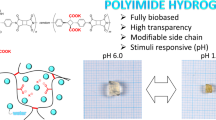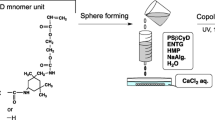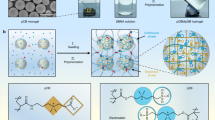Abstract
Random copolymers, poly(N-hydroxyethyl L-glutamine-co-N-hydroxypentyl L-glutamine) (PHPeEG) and poly(N-hydroxypropyl L-glutamine-co-N-hydroxypentyl L-glutamine) (PHPePG) as well as the corresponding homopolymers, poly(N-hydroxyethyl L-glutamine) (PHEG), poly(N-hydroxypropyl L-glutamine) (PHPG), and poly(N-hydroxypenthyl L-glutamine) (PHPeG), were prepared by aminolysis in the presence of the crosslinking agent, octamethylenediamine (OMDA), of a membrane of poly(γ-benzyl-L-glutamate). Membrane properties, such as the degree of swelling Qw, conformational property, tensile property, water vapor permeability and enzymatic degradation behavior were studied in the pseudo-extracellular fluid (PECF). Qw and molecular conformation are dependent on the composition of random copolymers. The mechanical strength of PHEG and PHPG hydrogels has been improved largely by introducing HPeG residues. Suitable mechanical property and water vapor permeability were obtained in some copolymers, which were compatible as skin substitutes. When compared at the same Qw, PHPePG copolymers were shown to have higher helix content and mechanical strength, lower water vapor permeability and faster papain digestion than PHPeEG copolymers. This can be explained by differences in hydrophobicity between PHEG and PHPG.
Similar content being viewed by others
Log in or create a free account to read this content
Gain free access to this article, as well as selected content from this journal and more on nature.com
or
References
S. D. Bruck, Biomater. Med. Dev. Artif. Organs, 1, 79 (1973).
B. D. Ratner and A. S. Hoffman, in “Hydrogels for Medical and Related Applications,” J. D. Andrade, Ed., ACS Symp. No. 31, ACS, Washington D. C., 1976, Chapter 1.
J. M. Anderson, K. L. Spilizewski, and A. Hiltner, in “Biocompatibility of Tissue Analogs,” D. F. Williams, Ed., CRC Press, Boca Raton, FL, 1985, p 68.
E. Nakanishi, E. Sugiyama, Y. Shimizu, S. Hibi, and T. Hayashi, Polym. J., 23, 983 (1991).
C. A. Homsey, J. Biomed. Mater. Res., 4, 341 (1971).
T. Hayashi, E. Nakanishi, and A. Nakajima, Kobunshi Ronbunshu, 43, 633 (1986).
H. E. Auer and P. Doty, Biochemistry, 5, 1708 (1966).
T. Sugie and P. A. Hiltner, J. Macromol. Sci. -Phys., B17, 769 (1980).
T. Miyazawa, J. Masuda, and K. Fukushima, J. Polym. Sci., 62, 62, (1966).
T. Hayashi, K. Takeshima, E. Kobatake, and A. Nakajima, Kobunshi Ronbunshu, 42, 777 (1985).
H. B. Bensusan, Biochemistry, 8, 4716 (1969).
J. Lowbridge and J. S. Fruton, J. Biol. Chem., 249, 6754 (1974).
N. Lotan, A. Yaron, A. Berger, and M. Sela, Biopolymers, 3, 625 (1965).
N. Lotan, A. S. Yaron, and A. Berger, Biopolymers, 4, 365 (1966).
N. Lotan, N. Bixon, and A. Berger, Biopolymers, 8, 247 (1969).
H. Yamada, in “Strength of Biological Materials,” F. G. Evans, Ed., WWC Press, 1970, p 226.
J. Hubacek, K. Kliment, J. Dusek, and J. Hubacek, J. Biomed. Mater. Res., 1, 387 (1967).
I. R. Schmolka, J. Biomed. Mater. Res., 6, 571 (1972).
J. Guldalian, C. Jelenko, III, D. Calloway, and J. T. McKnight, J. Trauma., 13, 32 (1973).
I. V. Yannas and J. F. Burke, J. Biomed. Mater. Res., 14, 65 (1980).
D. F. Williams, J. Bioeng., 1, 279 (1977).
T. N. Salthouse, J. Biomed. Mater. Res., 10, 197 (1976).
J. Drenth, J. N. Jansonius, R. Koekoek, and B. G. Solthers, “Papain, X-Ray Structure, in the Enzymes,” Vol. III, P. D. Boyer, Ed., Academic Press, New York, N. Y., 1971, p 485.
J. Lowbridge and J. S. Fruton, J. Biol. Chem., 249, 6754 (1974).
T. Hayashi, E. Nakanishi, and A. Nakajima, Polym. J., 19, 1025 (1987).
Author information
Authors and Affiliations
Rights and permissions
About this article
Cite this article
Nakanishi, E., Shimizu, Y., Ogura, K. et al. Effects of Side Chain Length on Membrane Properties of Copoly(N-hydroxyalkyl L-glutamine) Hydrogels. Polym J 23, 1061–1068 (1991). https://doi.org/10.1295/polymj.23.1061
Issue date:
DOI: https://doi.org/10.1295/polymj.23.1061



